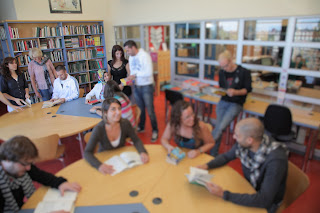Growing Up as a Teacher in the 'Web 2.0' Era:
Teacher Stephanie Pinkin says the evolution of web-based technologies has changed teaching more than educators often realize.
Teacher Stephanie Pinkin says the evolution of web-based technologies has changed teaching more than educators often realize.
I must say that I am proud of myself for trying out new technology as it becomes available. This pride is yet another encouraging factor that keeps me loving my job and looking forward to how it continues to change under Web 2.0.
Please understand this raving about online tools doesn’t mean I never get overwhelmed by them. When I attend a tech-heavy professional development session, I still leave with my head in a cloud and experience the same amount of panic all of us feel when something new is put on our plates. What I have learned about the benefits of embracing these tools is that I just need to always be on the hunt for technology that will make me a more effective and more efficient teacher. “Doing technology” just for a check-mark on my summative evaluation is not going to achieve anything substantial.





